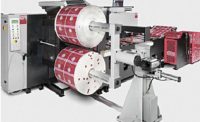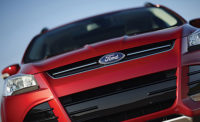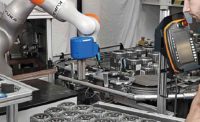Like any technology, welding continues to evolve. This is especially true for a technique known as flash-butt welding, which has been around since the early 20th century.
In flash-butt welding, electrical resistance heats the ends of two metal pieces to a molten state so they can be forged together into continuous coils, wheel rims, rods, band saw blades and other shapes requiring seamless joints at parent metal strength. Because irregularities and impurities are removed during the flash phase (application of electrical current), the technology can join narrow and thick shapes, wide and thin metal sheets, and ferrous and nonferrous metals.
Older welding machines rely on manual cams to move pieces together at the right velocity. Today’s advanced high-strength steel products, however, need much greater accuracy and controlled timing—down to thousandths of an inch and a few milliseconds.
One solution is to replace the cams with electric servo drives and use multiple PLCs to control the process. However, that can result in a machine that is too expensive to be widely adapted.
Taylor-Winfield Technologies Inc., an OEM of automated assembly systems and welding machines based in Youngstown, OH, devised another approach. It uses an IndraMotion MLC L45 motion logic controller with hydraulic drives, all of which are made by Bosch Rexroth. This solution is precise, scalable to various applications and cost-effective.
“There’s a growing need for flash-butt welding in aerospace, automotive, appliance and other industries requiring seamless joints in products made from high-strength metals,” says Blake Rhein, vice president of sales and marketing for Taylor-Winfield. “The [controller-and-drives] solution is so simple and accurate, we believe it will revolutionize how this type of welding is done around the world.”
Prior to beginning the welding process, an operator loads a welding curve depicting the time and position relationship between the two pieces into the controller. He then uses an IndraControl VPP 40 HMI to select the proper weld schedule (welding time, flashing distance, weld current, upset time) and modify the weld curve for the particular material.
The pieces begin with up to a 0.25-inch gap and a stationary platen between them. During the flash phase, a 4WRPH directional valve activates a linear positioning cylinder that moves the platen containing the mobile workpiece toward the stationary workpiece. The mobile piece generates forces up to 1 million psi to forge the pieces together. Welding lasts from 2 to 30 seconds, depending on material.
The controller’s Flex Profile platform allows for simple programming of electronic and hydraulic motion control tasks. Taylor-Winfield uses an Open Core Engineering interface to integrate the controller with hydraulic power units.
For more information on controllers and HMIs for flash-butt welding, call 800-739-7684 or visit www.boschrexroth-us.com.





